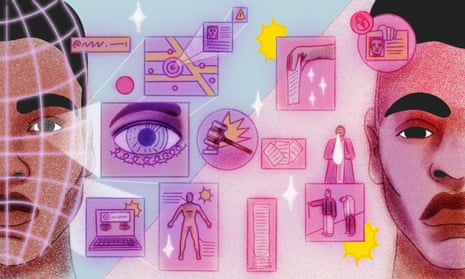The first time Caleb Kenyon, a defense attorney in Florida, saw a geofence warrant was when a new client received an alarming email from Google in January 2020. Local police were requesting personal data from the client, Zachary McCoy, and Kenyon had just seven days to stop Google from turning it over, the email said.
When Kenyon asked Google for more information, he received a copy of the warrant’s cover letter. It was unlike anything he or other lawyers in his network had ever seen.
The geofence warrant included a map and GPS coordinates, and instructed Google to provide identifying information for every user whose device was found within the radius of that location at a certain date and time.
“It was so bizarre that I just didn’t even have a concept for what I was dealing with,” he said.
Kenyon is not alone. As tech firms build ever more sophisticated means of surveilling people and their devices – technology that law enforcement is eager to take advantage of – the legal community is scrambling to keep up.
Public defenders are often the most overworked and underpaid lawyers in the criminal justice system, with little time and few resources to research the new technology now being used against their clients. This, in turn, creates an uneven playing field that disadvantages the most vulnerable people: those who can’t afford private attorneys. That’s where organizations like the National Association of Criminal Defense Lawyers (NACDL), a non-profit criminal legal advocacy group that Kenyon was a member of, come in. With an army of on-call experts, resources kits and trainings, the NACDL helps attorneys navigate the increasingly complex and novel ways their clients’ privacy can be violated in the digital age – including geofence and keyword search warrants, digital device searches and facial recognition.
The NACDL recently created the Fourth Amendment Center, named for the constitutional right against unreasonable searches. The center is one of the few resources available for helping attorneys better understand how new technology is being used against their clients. Defense attorneys and public defenders don’t have much time to chase down tech firms like Google for information about how their clients are being surveilled, and that’s where the center believes it can provide the greatest value.
“They don’t have to do all this themselves,” says Mike Price, the center’s litigation director. “We can do the work, share that information and help them raise these issues in their cases in a way that doesn’t take two years.”
Leveling the playing field
Cognizant of Google’s impending deadline to hand over information about McCoy’s device, Kenyon turned to the Fourth Amendment Center. He copied the language from the warrant and posted it on the organization’s online forum.
Price called him almost immediately. “He walked me through everything,” Kenyon said. The geofence warrant meant that police were asking Google for information on all the devices that were near the location of an alleged crime at the approximate time it occurred, Price explained. McCoy’s device must have been one of them. (Google said that it rigorously examines law enforcement requests for “legal validity and constitutional concerns” and emphasized that location tracking is off by default and users can delete their location data at any time.)
Kenyon challenged the warrant with the guidance of Price and the NACDL. Police ultimately withdrew it.

When it comes to challenging these kinds of requests, the deck is stacked against public defenders and defense attorneys and, consequently, their clients.
It can be years before the defense community catches wind of the newest surveillance tools and data-tracking methods police are using, and there’s often little transparency. Situations like McCoy’s can be a rarity: legal requests typically come with gag orders or non-disclosure agreements, meaning the person whose information is being requested may not know about it for months, much less be able to challenge it. And even when the potential suspect is notified, attorneys may find themselves in uncharted territory.
One way that the Fourth Amendment Center, launched in 2018, works to level the playing field is by partnering with defense attorneys to challenge the ways law enforcement uses tech. When Kenyon first heard from Price in 2020, the center’s litigation director was working with another defense attorney on a geofence warrant-related case, which has since become the basis for the organization’s many resources on how these warrants work.
That case – which Price partnered on with a Virginia federal public defender named Laura Koenig – involved a man named Okello Chatrie who was charged with robbing a bank in 2019 after a geofence warrant issued to Google placed Chatrie’s device at the scene of the crime. When Price and Koenig challenged the validity of the warrant and any evidence it produced on behalf of Chatrie, it became one of the first geofence warrants to be tested in court.
Unlike other search warrants, geofence warrants don’t require probable cause or a specific suspect in mind; they gather information on anyone within the vicinity of an alleged crime. Advocates argue this violates the fourth amendment, but it wasn’t until the Chatrie case that the contours of the practice first came to light.
Price and Koenig asked the court to subpoena Google for testimony to learn how the company collects user location data, and what it does when police ask for it. This gave attorneys and the public one of the first looks inside the process. Google testified, for instance, that it typically collects location data from devices every two minutes.
The judge ultimately ruled that geofence warrants are unconstitutional, setting a precedent that would give defense attorneys across the country new ground to challenge them. However, the judge made an exception in Chatrie’s case – a decision attorneys expect to appeal later this month.
“It’s one of the reasons we’ve been so heavily involved in the litigation over geofence warrants,” Price said. “There was a complete lack of transparency for a long time even about their existence, and in the cases we first started seeing them it took years to get information out of Google.”
Now, as a result of the Chatrie case, the NACDL has a geofence primer kit for attorneys that includes questions they should ask when one has been issued, as well as sample briefs and motions. They have also shared transcripts from Google’s testimony and copies of the subpoena on their website.
‘Like playing Whac-A-Mole’
The organization regularly hosts trainings and webinars that are attended by 30 to 800 people at a time, according to Jumana Musa, the Fourth Amendment Center’s director. Geofence warrants are just one of several topics the NACDL offers litigation assistance on. Others include ShotSpotter, a gunshot detection technology currently being used by police to monitor neighborhoods for gun crimes; defending clients from potential abortion-related surveillance in a post-Roe world; and how to fight the search and seizure of digital devices.

Public defenders – who can be juggling as many as 70 or more cases at a time and have fewer resources and less time than the prosecution – stand to benefit the most from the NACDL’s services, Musa said. Clients relying on a public defender because they cannot afford their own attorney also happen to be more likely to be targeted by law enforcement and come from predominantly Bipoc, immigrant or multi-marginalized communities.
“Often for the folks who are most targeted by these tools and the criminal legal system, the only person standing between them and a jail cell is their public defender,” she said.
When Musa first joined the NACDL, the Fourth Amendment Center didn’t exist. At the time, her work was focused on affecting policy changes at the congressional level. The work was slow and incremental, she said, and reform often came with tradeoffs that harmed people in the criminal legal system. The hope is that the center will make an impact by helping public defenders and defense attorneys address issues posed by newer technologies.
Still, their work can feel like playing Whac-A-Mole, Price said. Even as the group identifies and learns about new ways of monitoring people’s data, the rapid advance of new technologies outpaces them. “You have to imagine companies like Google know that if they collect [the data], [law enforcement] will come.”
The NACDL hopes to find a case it can eventually bring to the supreme court to test and challenge the constitutionality of these surveillance mechanisms. In the meantime, it will continue to fight for awareness, one courtroom at a time.
